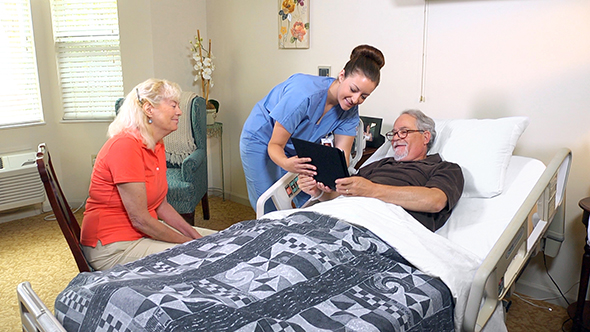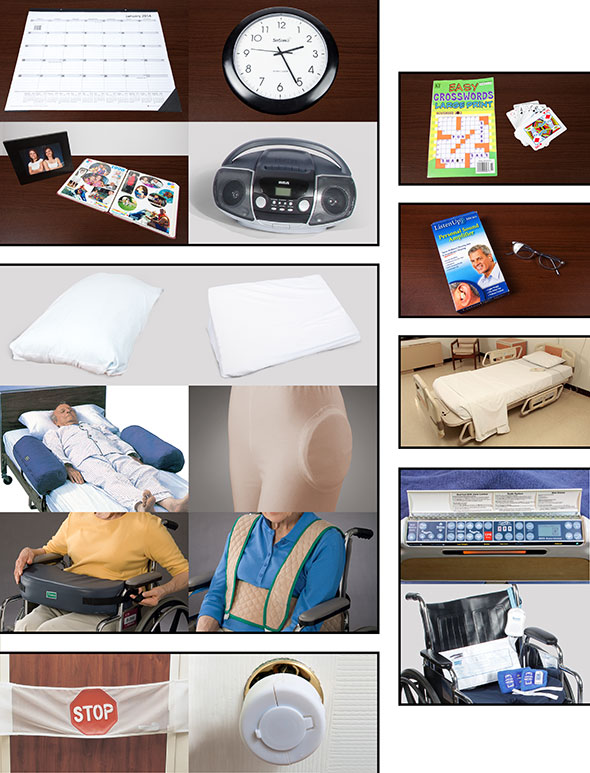Infection Control and Safety Measures
Select a Skill:
- » Performing Hand Hygiene
- » Using Personal Protective Equipment
- » Using Restraint Alternatives
- » Applying Restraints Safely
Take the Review Test:

Purpose

- Restraint alternatives are used to prevent injuries and falls while upholding the person’s right to be restraint free.
- Restraint alternatives also are used to prevent self-injury, such as from pulling out tubes. Also, they are used to prevent complications of restraints.
- Alternatives to restraints include:
- Warning devices, such as bed, wheelchair, or chair alarms
- Floor cushions
- Knob guards and barrier signs on doors
- Roll guards attached to the bed frame
- Wedge cushions in wheelchairs
- Activities and diversions
- Pillows and other posture and positioning aids
- Padded hip protectors
- Furniture that meets the patient’s needs, such as a low bed or a recliner
Equipment
Roll cursor over items to see labels. For the purposes of clearly depicting the equipment, a barrier is not shown in this photo. When providing care, a barrier should always be placed on the surface before placing the equipment.

Large calendar
Clock with large numbers
Framed family photo
Family photo album
Radio/CD player
Pillow
Wedge cushion
Roll guards
Hip protectors
Posture support
Torso support
Stop sign barrier
Doorknob cover
Crossword puzzle book
Deck of playing cards
Hearing aids
Eyeglasses
Low bed
Bed alarm
Wheelchair/Chair alarm
Pressure sensitive alarm
Personal medical alarm
Delegation

Check with the nurse and the person’s care plan about what type of restraint alternative to use.
Preparation
- Observe quality-of-life measures.
- Ensure that:
- The state law allows a nursing assistant to perform this procedure.
- The procedure is in your job description.
- You have been taught how to perform the procedure.
- A nurse is available for supervision and questions.
- Observe the person’s physical and mental status.
Safety

- Make sure that the person’s eyeglasses, hearing aids, or other sensory aids are on and working properly.
- Always follow the manufacturer’s instructions for using a warning device, such as a chair, bed, or door alarm.
- Observe and visit the person at least every 15 minutes or as often as noted in the care plan.
- Be aware that getting out of bed for toileting is one of the most common events leading to falls, especially when the room is darkened.
- Approach a disoriented patient in a calm, non-threatening, professional manner. This is especially helpful when the environment is different from the person’s usual one.
Comfort
- Ensure that the person’s food, fluid, hygiene, and elimination needs are met.
- Keep the signal light within the person’s reach and answer it promptly.
Procedure Video
Audio Description: OFFFollow-up Care
- Provide for comfort.
- Complete a safety check of the room.
- Observe the patient’s behavior toward staff members, visitors, and other patients. Note behavior that increases the risk of self-injury or injury to others.
Reporting/Recording
- Notify the nurse if you observed any behavior problems or other concerns.
- Document the procedure according to facility policy.
Review Questions
Select the best answer.
1. What is the purpose of using a restraint alternative?
 To prevent the person from getting out of bed
To prevent the person from getting out of bed To prevent self-injury, such as from pulling out tubes
To prevent self-injury, such as from pulling out tubes To punish the person who does not use the signal light
To punish the person who does not use the signal light To prevent the facility from being sued if the person is injured
To prevent the facility from being sued if the person is injured
Select the best answer.
2. Before using a restraint alternative, what should you do?
 Check with the nurse about what type of restraint alternative to use
Check with the nurse about what type of restraint alternative to use Ask another nursing assistant to supervise the procedure
Ask another nursing assistant to supervise the procedure Try using various restraints to keep the person from self-injury
Try using various restraints to keep the person from self-injury Ask the person’s doctor to order a restraint, such as a vest
Ask the person’s doctor to order a restraint, such as a vest
Select the best answer.
3. Which restraint alternative could be used to prevent a confused person from wandering into another person’s room?
 A floor cushion next to the bed
A floor cushion next to the bed A bed or chair alarm
A bed or chair alarm A padded hip protector
A padded hip protector A knob guard on the door
A knob guard on the door
Select the best answer.
4. Which of these devices is a restraint alternative?
 Roll guards that are attached to the bed frame
Roll guards that are attached to the bed frame Velcro used to hold clothing tight enough to restrict movement
Velcro used to hold clothing tight enough to restrict movement Bed rails that prevent the person from getting out of bed
Bed rails that prevent the person from getting out of bed A tray table that blocks the person’s freedom of movement
A tray table that blocks the person’s freedom of movement
Select the best answer.
5. Which technique is an alternative to restraint use?
 Observe the person at least once every 2 hours
Observe the person at least once every 2 hours Discourage visitors because they can cause confusion
Discourage visitors because they can cause confusion Provide diversions, such as TV, videos, music, and games
Provide diversions, such as TV, videos, music, and games Remove clocks and calendars for a person with confusion
Remove clocks and calendars for a person with confusion
You have completed the Review Questions for this skill. To take the Review again select the Start Over button. To proceed to another skill select from the dropdown menu. Select the Home or Back button to proceed to the next section.

